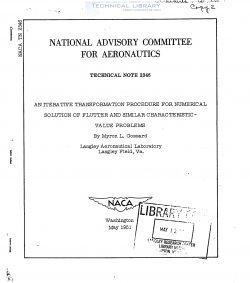naca-tn-2346
- Version
- 136 Downloads
- 2.47 MB File Size
- 1 File Count
- December 14, 2016 Create Date
- December 14, 2016 Last Updated
National Advisory Committee for Aeronautics, Technical Notes - An Iterative Transformation Procedure for Numerical Solution of Flutter and Similar Characteristic Value Problems

An iterative transformation procedure suggested by H. Wielandt for
numerical solution of flutter and similar characteristic-value problems
is presented. Application_of this procedure to ordinary natural—
vibration problems and to flutter problems is shown by numerical
examples. Comparisons of computed results with experimental values and
with results obtained by other methods of analysis are made.
Existing methods of flutter analysis include the representative-
section method, generalized—coordinate methods, matrix methods, and
operational methods. The present paper presents an iteration procedure
for analysis of flutter and similar characteristic—value problems.
For ordinary natural-vibration problems, iterative procedures of
the Stodola type (references 1 and 2) are suitable for finding the funda-
mental and higher-order natural modes and frequencies. The higher-order
solutions are obtained through use of the orthogonality relations that
exist among the natural modes.
Orthogonality relations analogous to those that exist in ordinary
vibration problems can be found in the flutter problem only by intro—
duction of the so-called "adjoint" problem. (This additional step is
unnecessary in ordinary vibration problems by virtue of the fact that
they are "self-adjoint.") Wielandt has suggested an iterative transfor-
mation procedure (reference 3) which is well-suited to the flutter
problem in that it avoids the need of orthogonality relations and hence
does not require consideration of the adjoint_problem. The iterative
transformation procedure can also be applied to ordinary natural-
vibration problems with less labor than is generally required in the
extended Stodola procedure.
Because both the original and translated works of Wielandtmare ==
difficult to follow, an explanation of the idea of_the iterative trans—
formation procedure is given in the present paper and the application ~
of the procedure to ordinary naturalrvibration problems and to flexure-
torsion flutter problems is shown in numerical examples. Comparisons
of computed results with experimental values and with results obtained
by other methods of analysis are also made.
| File | Action |
|---|---|
| naca-tn-2346 An Iterative Transformation Procedure for Numerical Solution of Flutter and Similar Characteristic Value Problems.pdf | Download |

Comment On This Post